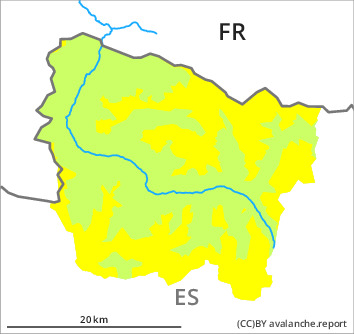
Danger level

2300m
Avalanche Problem

Wind-drifted snow

2300m


Wind slabs at high altitude.
As a consequence of a moderate to strong wind from southeasterly directions, precarious wind slabs formed adjacent to ridgelines and in gullies and bowls. They are mostly only small but can in some cases be released easily. Above approximately 2300 m and in the valleys bordering the Ribagorçana basin and the Pallaresa basin the avalanche prone locations are more prevalent and the danger is greater.
As a consequence of warming during the day and solar radiation small moist snow slides are possible in all altitude zones. Individual gliding avalanches can also occur.
As a consequence of warming during the day and solar radiation small moist snow slides are possible in all altitude zones. Individual gliding avalanches can also occur.
Snowpack
>
The new snow of the last few days is lying on a crust in all aspects. This snow is bonding only slowly with the old snowpack in particular on very steep, little used shady slopes and at high altitude.
Low and intermediate altitudes: The old snowpack will be generally moist. The surface of the snowpack will freeze to form a strong crust and will soften during the day.
Above approximately 2000 m there are 100 to 200 cm of snow. At high altitudes and in high Alpine regions snow depths vary greatly, depending on the infuence of the wind.
Low and intermediate altitudes: The old snowpack will be generally moist. The surface of the snowpack will freeze to form a strong crust and will soften during the day.
Above approximately 2000 m there are 100 to 200 cm of snow. At high altitudes and in high Alpine regions snow depths vary greatly, depending on the infuence of the wind.
Tendency
Slight increase in danger of moist avalanches as the moisture increases. The danger of dry avalanches will decrease gradually.